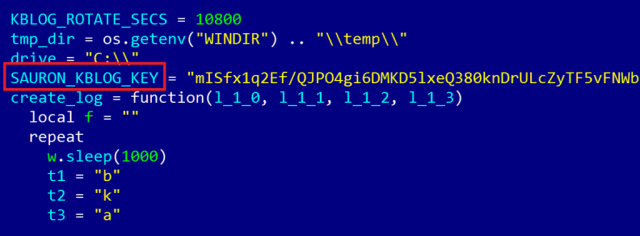Researchers crack open unusually advanced malware that hid for 5 years
Researchers crack open unusually advanced malware that hid for 5 years

Espionage platform with more than 50 modules was almost certainly state sponsored.
Dan Goodin -8/9/2016, 2:41 AM via arstechnicz.com
The name "Project Sauron" came from code contained in one of the malware's configuration files.
Kaspersky Lab
Security experts have discovered a malware platform that's so advanced in its design and execution that it could probably have been developed only with the active support of a nation state.
The malware—known alternatively as "ProjectSauron" by researchers from Kaspersky Lab and "Remsec" by their counterparts from Symantec—has been active since at least 2011 and has been discovered on 30 or so targets. Its ability to operate undetected for five years is a testament to its creators, who clearly studied other state-sponsored hacking groups in an attempt to replicate their advances and avoid their mistakes. State-sponsored groups have been responsible for malware like the Stuxnet- or National Security Agency-linked Flame, Duqu, and Regin. Much of ProjectSauron resides solely in computer memory and was written in the form of Binary Large Objects, making it hard to detect using antivirus.
Because of the way the software was written, clues left behind by ProjectSauron in so-called software artifacts are unique to each of its targets. That means that clues collected from one infection don't help researchers uncover new infections. Unlike many malware operations that reuse servers, domain names, or IP addresses for command and control channels, the people behind ProjectSauron chose a different one for almost every target."The attackers clearly understand that we as researchers are always looking for patterns," Kaspersky researchers wrote in a report published Monday. "Remove the patterns and the operation will be harder to discover. We are aware of more than 30 organizations attacked, but we are sure that this is just a tiny tip of the iceberg." Symantec researchers, in a report of their own, said they were aware of seven organizations infected.
Jumping air gaps
Part of what makes ProjectSauron's so impressive is its ability to collect data from air-gapped computers. To do this, it uses specially prepared USB storage drives that have a virtual file system that isn't viewable by the Windows operating system. To infected computers, the removable drives appear to be approved devices, but behind the scenes are several hundred megabytes reserved for storing data that is kept on the air-gapped machines. The arrangement works even against computers in which data-loss prevention software blocks the use of unknown USB drives.Kaspersky researchers still aren't sure precisely how the USB-enabled exfiltration works. The presence of the invisible storage area doesn't in itself allow attackers to seize control of air-gapped computers. The researchers suspect the capability is used only in rare cases and requires use of a zero-day exploit that has yet to be discovered. In all, Project Sauron is made up of at least 50 modules that can be mixed and matched to suit the objectives of each individual infection."Once installed, the main Project Sauron modules start working as 'sleeper cells,' displaying no activity of their own and waiting for 'wake-up' commands in the incoming network traffic," Kaspersky researchers wrote in a separate blog post. "This method of operation ensures Project Sauron’s extended persistence on the servers of targeted organizations."Kaspersky researchers said they discovered the malware last September after a customer at an unidentified government organization hired them to investigate anomalous network traffic. They eventually unearthed a "strange" executable program library that was loaded into the memory of one of the customer's domain controller servers. The library was masquerading as a Windows password filter, which is something administrators typically use to ensure passwords match specific requirements for length and complexity. The module started every time a network or local user logged in or changed a password, and it was able to view passcodes in plaintext.The main purpose of the malware platform was to obtain passwords, cryptographic keys, configuration files, and IP addresses of the key servers related to any encryption software that was in use. Infected groups include government agencies, scientific research centers, military organizations, telecommunication providers, and financial institutions in Russia, Iran, Rwanda, China, Sweden, Belgium, and possibly in Italian-speaking countries.Kaspersky researchers estimate that development and operation of the Sauron malware is likely to have required several specialist teams and a budget in the millions of dollars. The researchers went on to speculate that the project was funded by a nation state, but they stopped short of saying which one."The actor behind ProjectSauron is very advanced, comparable only to the top-of-the top in terms of sophistication: alongside Duqu, Flame, Equation, and Regin," the Kaspersky researchers wrote. "Whether related or unrelated to these advanced actors, the ProjectSauron attackers have definitely learned from them."